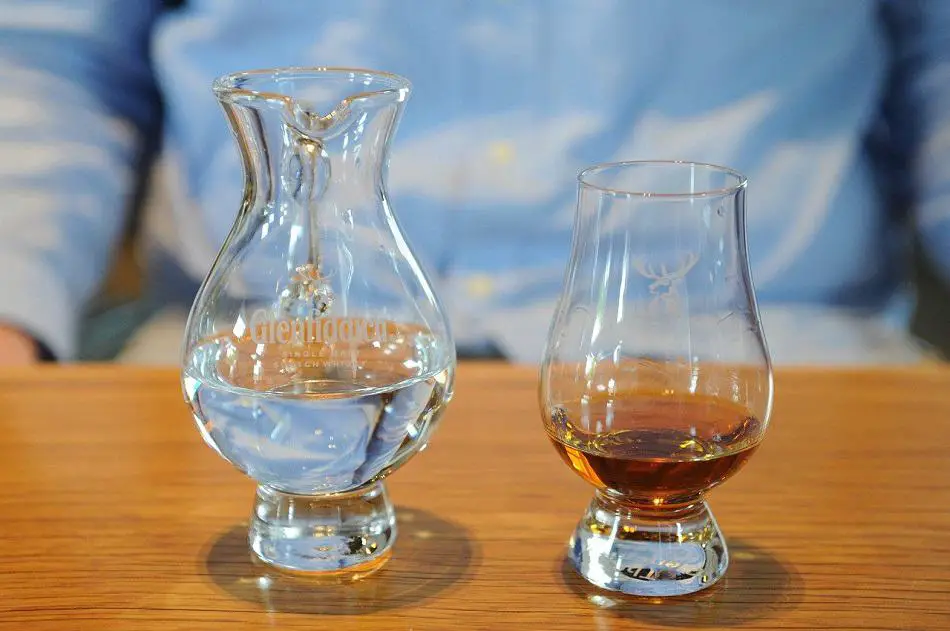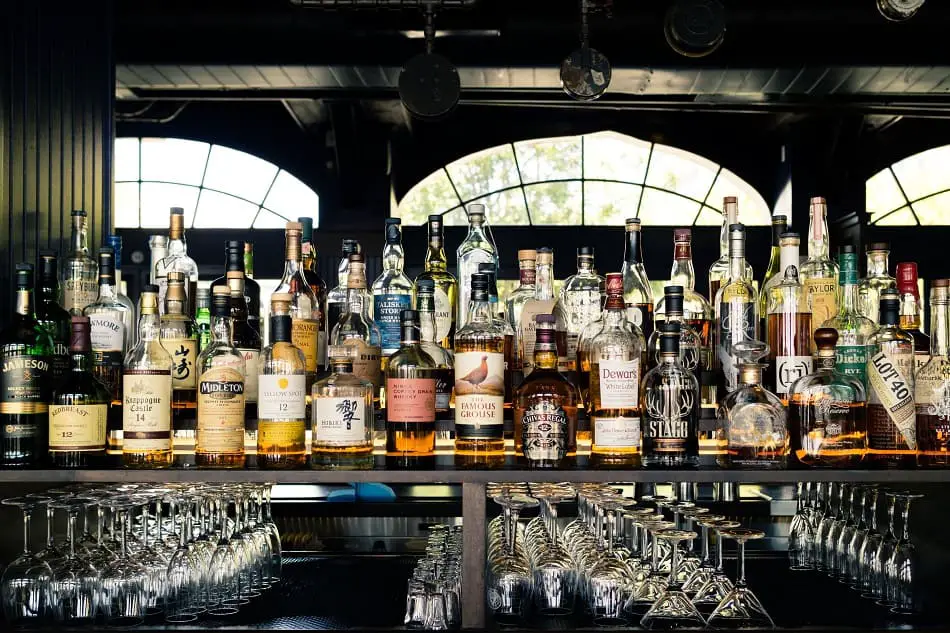In the days when I knew very little about whiskey, I wondered why anyone would drink it. It burned my tongue, my throat and my mouth, it tasted harsh and unpleasant, and I had to pay a lot of money for that experience. However, after learning a little more, I discovered that whiskey really does taste good. As long as you do these three things:

1. Reduce the Impact of the Alcohol
Whiskey tastes good if you reduce the impact of the alcohol.
This is because whiskey actually has lots and lots of delicious flavors. I know, it surprised me too when I first discovered this.
The problem is that whiskey also has a high alcohol content level (anywhere from 40%ABV – 68%ABV) which keeps some of the whiskey’s flavors closed up, overpowers those that aren’t with its unpleasant taste and burns your nose and mouth making it difficult to taste anything anyway.
Is it any wonder that so many people are unaware that whiskey tastes good?
Reducing the impact of the alcohol means it won’t burn, you can actually taste the whiskey itself and more of its flavors will open up. You do this by:
Using a nosing glass. These are glasses with wide bowls and long narrow necks. The wide bowl means there’s plenty of room for air to get to the whiskey. This lets the whiskey breathe so some of the alcohol can evaporate.
On the other hand, when you drink from a shot glass there’s no room for air to get to the whiskey and none of the alcohol will evaporate. You’ll be drinking the whiskey at its full alcoholic strength.
Letting the whiskey sit. When you pour your whiskey, don’t drink it straightaway. Let it sit untouched for a few minutes. This gives the air, which since you’re using a nosing glass can get to the whiskey, time to cause more of the alcohol to evaporate.
It’s not always practical but if you let your whiskey sit for an hour or two, the decrease in the ratio of alcohol to whiskey will make its flavors much more intense.
Adding a few drops of water. Diluting whiskey is another way of reducing the impact of the alcohol although this time it’s not by causing the amount of alcohol to decrease but by increasing the amount of non-alcohol.
Some add only a few drops of water, others a large splash. The precise amount will vary by person and whiskey, and you’ll have to experiment to find out how much water will make a given whiskey taste best for you. In other words, add water gradually so that you don’t end up diluting your whiskey too much.

Chilling your whiskey with ice. This reduces the impact of the alcohol in two ways. Firstly, by lowering the temperature of the whiskey you reduce its intensity and the burn of the alcohol. Secondly, it will add water and dilute your whiskey as the ice melts.
Letting your nose and palate acclimatize to the alcohol. Your nose and palate are delicate and strong alcohol can easily numb them. When you smell the whiskey do so gently so that your nose can get used to the strength of the alcohol. Similarly, let your mouth get used to the strength of the alcohol by drinking a small sip before you try and taste it.
You’re first smell and taste will be of alcohol, but once your nose and palate adjust, you’ll be able to smell and taste the whiskey.
Desensitizing yourself to alcohol. Some people desensitize themselves to the taste and effects of alcohol by repeatedly drinking some until they get used to it. They either drink whiskey every day until it stops burning or start with very diluted whiskey and reduce the amount it’s diluted each day until they’re drinking full strength whiskey.
A similar but less drastic approach is to start off by drinking whiskey cocktails. Drink those with more non-whiskey / alcohol ingredients such as a Whiskey Highball and work your way to a Manhattan that’s two parts whiskey but one part sweet vermouth.
2. Drink Whiskey(s) With Flavors You Like
Whiskey tastes good if it has flavors you like.
You see whiskey doesn’t refer to one drink with one or two specific flavors that some people really like but others find really disgusting. It refers to a drink that depending on exactly how it’s made, can have any of hundreds of flavors and many have dozens of flavors at the same time.
There are many different whiskeys out there, each with different flavor profiles, some of which can taste completely different. Just because you were once unlucky enough to have been cajoled by a friend or relative into trying a whiskey they swore was absolutely delicious – to their bizarre palate, doesn’t mean that all whiskeys have the flavor of a wet dog.
This means that whiskey really does taste good as long as you only drink whiskeys with flavors you like and stay away from whiskeys with flavors you don’t. All you need to do is decide on the flavors you like and find whiskeys that have them.

Now this may seem difficult, but I caused this problem so it’s only fair that I help solve it by telling you some flavors you can expect to find in certain types of whiskeys.
Some of a whiskey’s flavors come from the grain used to make it. Here are the most commonly used grains and some of the flavors they give the whiskey:
- Malted barley – sweet with lots of caramel; toffee, brown sugar, nuts, smoke and chocolate
- Corn – sweet with a syrupy taste; white sugar, cotton candy, vanilla and maple syrup
- Rye – spicy and dry, with pepper and cinnamon
- Wheat – wheat bread and honey
Most of a whiskey’s flavors come from the casks they’re matured in. Here are the most commonly used casks and some of the flavors they give the whiskey.
- American oak – sweet, caramel, vanilla, cinnamon, and brown sugar
- European oak – dry, spicy, toasted almonds, nutmeg, vanilla and toffee
Different countries are known for producing different types of whiskeys. Here are the main whiskey producing countries and the types of whiskeys they’re known for:
| Common Flavors | |
|---|---|
| Scotch from Lowlands | Malt, citrus with grass, honeysuckle, cream, ginger, toffee, toast and cinnamon |
| Scotch from Highlands | Oak, heather, dried fruit, fruitcake, smoke, cereal and dried fruit. If the distillery is near the sea, you’ll get salty maritime flavors |
| Scotch from Speyside | Fruity, spicy with apple, pears, nutmeg, vanilla, and sometimes smoke |
| Scotch from Campbeltown | Fruity, peaty, sweet and smoky. There will be notes of sea salt and a briny taste along with vanilla and toffee flavors |
| Scotch from Islay | Peaty, smoky, earthy and oily with a hint of salty sea air, brine and seaweed |
| Irish Whiskey | Fruity with a grassy freshness and flavors including malt, vanilla, cream, oranges, lime, mandarin, marmalade and wood |
| Bourbon | Very sweet and smooth with vanilla, caramel, honey and oak |
| Tennessee Whiskey | Same as bourbon but somewhat smoky and sooty |
| American Rye Whiskey | Less sweet than bourbon, but spicier, grainier and drier |
| Canadian Whisky | Light and sweet but full of flavor. If made with rye it will be spicy |
If all the above doesn’t help, then you’re just going to have to try as many whiskeys as possible. In fact, it’s a good idea anyway as you may find yourself liking a whiskey that from its flavor profile you thought you wouldn’t.
However, you might want to try them in the following order:
Bourbon. In general, American whiskeys have the sweetest taste. Bourbon is the sweetest whiskey due to being made from corn – the most sugary grain used in whiskey production, and so it’s the easiest whiskey to drink. Tennessee whiskey which tastes like bourbon is sweeter according to some.
Irish whiskeys. When you’re ready to move on from bourbon, your next step is Irish whiskeys. They’re not too much of a stretch as they can be quite bourbon-like but they’re definitely not as sweet. They are however, lighter and fruitier than Scotch whiskies, and because they’re triple distilled and usually made without peat, much smoother too.
Scotch whiskies. These whiskies can have the least palatable flavors but with five Scotch whisky regions producing widely varying types of whiskies, you’ll find plenty with flavors you like.
Whiskies from the Highland and Speyside regions produce lighter, sweeter and fruitier scotches, so definitely start with them before moving on to the most pungent, peaty and smoky scotches that come from the region of Islay.
You can find more information about the taste of whiskey in a more detailed article I wrote on it here.
3. Explore Its Aromas and Flavors
Whiskey tastes good if you explore its aromas and flavors.
Obviously if you throw back a couple of shots where the whiskey barely touches your tongue, you’re not going to taste anything, but even a quick sip where you taste something will leave you missing out on most of the whiskey’s flavors.
Instead, you need to explore a whiskey’s aromas and flavors by nosing and chewing your drink.
This may sound complicated or worse, pretentious, but it’s much easier (and less pretentious) than it sounds.
Nosing your whiskey just means smelling it. It’s important to smell your whiskey because flavor is smell as well as taste, so if you don’t smell your whiskey’s aromas, you’ll be losing some of its flavors.

This is another reason why using a nosing glass to drink whiskey is important, because while the wide bowl lets air get to the whiskey so the alcohol can evaporate, the long narrow neck lets the whiskey’s aromas accumulate so you can smell them.
On the other hand, when you drink from a shot glass not only is there no room for air to get to the whiskey but there’s also nowhere for its aromas to accumulate. They would dissipate and you would lose a certain amount of the whiskey’s flavors.
To nose your whiskey, do the following:
- Put your nose into the glass and breathe in deeply but gently – as mentioned you don’t want your nose to be singed by the alcohol.
- Sniff using one nostril then the other. Generally, one nostril is responsible for 80% of an inhalation while the other is obstructed, so each nostril will perceive the aromas differently.
- Vary your rate of inhalation because some aromas are easier to detect when the flow of air is rapid while others are easier to detect when the flow of air is slower.
- Examine every part of the glass because different aromas concentrate at different points. At the bottom you’ll find the heavier compounds with earthy, smoky, woody, aromas, higher up will be the spicy, malty, winey aromas and towards the rim are the lighter fruity and floral aromas.
Chewing your drink means holding it in your mouth and swirling it around. Make sure it spreads throughout your mouth and covers all the surfaces of your tongue – the middle, the sides, the tip and the back – because different parts of your tongue respond to different flavors.
At this point you will be picking up lots of flavors. Nod to yourself and admit that I was right. Whiskey really does taste good.
Swallow but don’t take another sip yet. Wait a moment so that the taste can come back up. This is called the finish. It will have some or all of the flavors you already tasted and sometimes even new ones. It will change as the flavors fade in your mouth.
Now is a good time to add water because as mentioned earlier, it opens up the whiskey’s flavors. Adding a drop of water or two between sips allows you to note any difference it makes to the taste of your whiskey.
You can find more information on how to drink whiskey, in a more detailed article I wrote about it here.
You may not pick up very much the first time you do this. You may also feel slightly ridiculous with a mouth full of whiskey. You may even deny that whiskey tastes good, but like anything else with practice it will become much easier to find a whiskey’s delicious flavors.
Now you may not want to practice smelling and tasting whiskey, after all you don’t have to do that to enjoy other foods and drinks, but I assure you the reward is totally worth it. Because, as long as you do the above mentioned three things, whiskey really does taste good.
